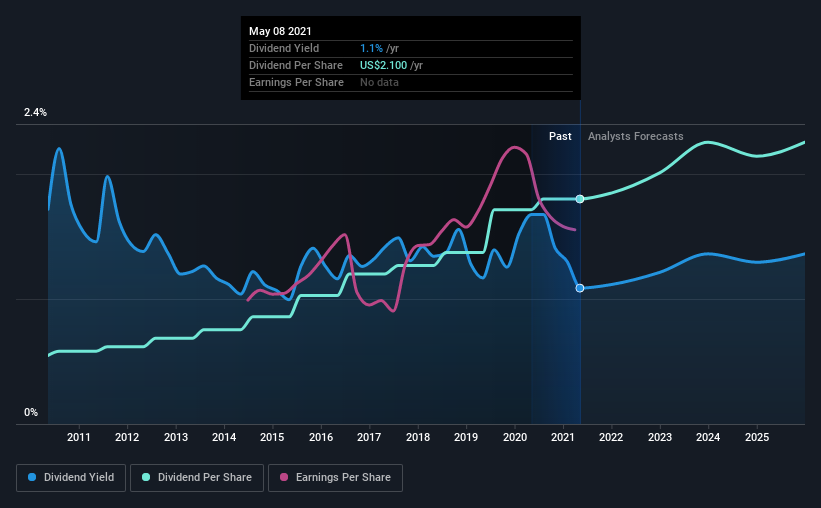Here's What We Like About Carlisle Companies' (NYSE:CSL) Upcoming Dividend
Readers hoping to buy Carlisle Companies Incorporated (NYSE:CSL) for its dividend will need to make their move shortly, as the stock is about to trade ex-dividend. Investors can purchase shares before the 14th of May in order to be eligible for this dividend, which will be paid on the 1st of June.
Carlisle Companies's upcoming dividend is US$0.53 a share, following on from the last 12 months, when the company distributed a total of US$2.10 per share to shareholders. Based on the last year's worth of payments, Carlisle Companies has a trailing yield of 1.1% on the current stock price of $193.2. If you buy this business for its dividend, you should have an idea of whether Carlisle Companies's dividend is reliable and sustainable. So we need to check whether the dividend payments are covered, and if earnings are growing.
View our latest analysis for Carlisle Companies
Dividends are typically paid out of company income, so if a company pays out more than it earned, its dividend is usually at a higher risk of being cut. Carlisle Companies paid out a comfortable 36% of its profit last year. Yet cash flows are even more important than profits for assessing a dividend, so we need to see if the company generated enough cash to pay its distribution. It paid out 18% of its free cash flow as dividends last year, which is conservatively low.
It's positive to see that Carlisle Companies's dividend is covered by both profits and cash flow, since this is generally a sign that the dividend is sustainable, and a lower payout ratio usually suggests a greater margin of safety before the dividend gets cut.
Click here to see the company's payout ratio, plus analyst estimates of its future dividends.
Have Earnings And Dividends Been Growing?
Businesses with strong growth prospects usually make the best dividend payers, because it's easier to grow dividends when earnings per share are improving. If business enters a downturn and the dividend is cut, the company could see its value fall precipitously. With that in mind, we're encouraged by the steady growth at Carlisle Companies, with earnings per share up 3.6% on average over the last five years. Earnings per share growth in recent times has not been a standout. However, companies that see their growth slow can often choose to pay out a greater percentage of earnings to shareholders, which could see the dividend continue to rise.
The main way most investors will assess a company's dividend prospects is by checking the historical rate of dividend growth. Since the start of our data, 10 years ago, Carlisle Companies has lifted its dividend by approximately 13% a year on average. It's encouraging to see the company lifting dividends while earnings are growing, suggesting at least some corporate interest in rewarding shareholders.
To Sum It Up
Has Carlisle Companies got what it takes to maintain its dividend payments? Earnings per share have been growing moderately, and Carlisle Companies is paying out less than half its earnings and cash flow as dividends, which is an attractive combination as it suggests the company is investing in growth. We would prefer to see earnings growing faster, but the best dividend stocks over the long term typically combine significant earnings per share growth with a low payout ratio, and Carlisle Companies is halfway there. Overall we think this is an attractive combination and worthy of further research.
With that in mind, a critical part of thorough stock research is being aware of any risks that stock currently faces. In terms of investment risks, we've identified 2 warning signs with Carlisle Companies and understanding them should be part of your investment process.
We wouldn't recommend just buying the first dividend stock you see, though. Here's a list of interesting dividend stocks with a greater than 2% yield and an upcoming dividend.
This article by Simply Wall St is general in nature. It does not constitute a recommendation to buy or sell any stock, and does not take account of your objectives, or your financial situation. We aim to bring you long-term focused analysis driven by fundamental data. Note that our analysis may not factor in the latest price-sensitive company announcements or qualitative material. Simply Wall St has no position in any stocks mentioned.
Have feedback on this article? Concerned about the content? Get in touch with us directly. Alternatively, email editorial-team (at) simplywallst.com.

